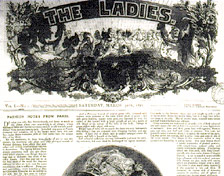The Ladies, a weekly newspaper published in London for nine months beginning in 1872, offered women advice on fashion, housekeeping, employment, and political activism. This selection of intriguing reproductions from the press will be a good resource for instructors focusing on women’s history in the Victorian era.
The Ladies divided its attention between discussions of fashion, the activities of the royal family, women’s suffrage, and domestic economy. The material provides readers with an engaging example of how an arena of women’s history—fashion—traditionally considered apolitical, can be understood in political terms. As site creator Virginia Cope indicates, one of The Ladies’ unusual features was that it proposed “an impossible dream of womanhood allowing for femininity, domesticity, brilliance, assertiveness, and political activism.” Cope discusses how the adoption of correct attire literally vested women with class legitimacy that might allow them greater social and political liberties.
The site features an introductory 1,000-word essay, reproductions of the entire first edition of the weekly, and various portions of later issues. Viewers can access articles and editorials and read from the pages of The Ladies’ gossip column (“Twitterings by a Little Bird”), its poetry section, and columns on both domestic science and women’s employment. The site includes contextual discussions of class issues, anti-suffrage criticism leveled at the press, and fashion in history. It also features reproductions of more than 30 engravings, advertisements published in the paper, and several pages of sheet music. A brief and partly annotated bibliography discusses primary and secondary materials.
Although instructors will find the collection of sources and secondary discussions contained in the site useful, Cope does not include extensive contextual material treating women’s history in this period. Viewers may wish to use the sources at the site in conjunction with the broader historical portrait presented in websites dealing with women’s history in the Victorian age such as http://www.victorianweb.org/ or http://www.history.ac.uk/ihr/Focus/Victorians/.
Navigation through the site could be improved. Currently, users must use the “back” button to return to the home page or to the sub-sections to access additional material. Direct links from the excerpts back to the home page and to other portions of the website would make it easier to move within the site.
Teachers could use material from The Ladies in a variety of ways. They might encourage students to use excerpts from the editorials contained in the subsection “The Ladies v. the Gentlemen of the Press” in order to examine the rhetorical basis upon which the paper defended women’s political activism. Alternatively, they might encourage students to reflect upon the discrepancies between the militant tone of its editorial support for suffrage and its unthreatening presentation of femininity in both its emphasis on fashion and its discussions of domestic economy. Did the paper use the image of traditional femininity as a means of masking its more radical intent? Or is the opposite reading more accurate?
The site could also be used as a basis for examining class tensions and gender in the Victorian age. The Ladies directed itself toward both an upper and aspiring middle-class readership, and its content reflects the tensions between these two groups. Although its editorials professed to condemn the vulgarity of class climbing, the publication, in fact, served as a guide to social mobility. Instructors could have students research the clues that the advertising or editorial content of the paper indicate about the range of readers to whom it appealed, and articulate the strategies it presented for rising in social status.



